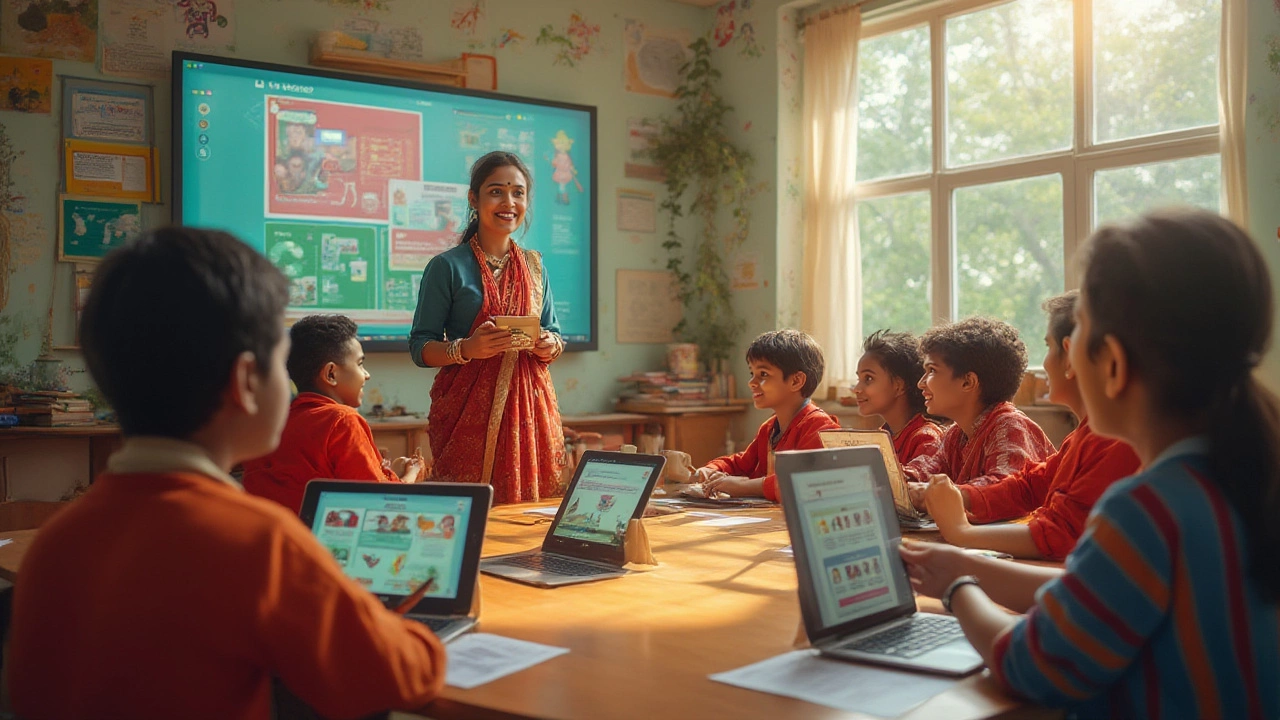
If you hear 'eLearning' and picture a generic online course, you’re missing the bigger picture. Around the globe, the way people talk about learning online changes almost as much as the technology itself. Some call it digital learning, others prefer virtual classrooms, and a few stick with the old-school distance education phrase. The names may shift, but the impact is easy to see—hundreds of millions log in to study, teach, and even earn degrees without ever stepping into a physical classroom. But what’s behind all the naming, and what does it actually mean for someone looking to learn from a laptop instead of a desk? Let’s break it down and see why the labels matter, and what’s happening right now in this digital education boom.
Why So Many Names? The Evolution of eLearning Lingo
Here’s something funny: nobody can quite agree on what to call eLearning. If you ask a university in New Zealand, they’ll likely say 'online learning' on their website. Across the Tasman, Aussie schools sometimes market 'virtual classrooms' and promise 'remote study.' In the US, you’ll hear 'digital education' or 'web-based training' tossed around. These names aren’t just marketing fluff—they actually highlight how the world’s been changing the way it learns for decades now.
Sexier terms like 'MOOCs' (Massive Open Online Courses) gained popularity after platforms like Coursera, edX, and FutureLearn started handing out courses to millions of users all over. Some folks still swear by 'distance learning,' dating back to correspondence courses with snail mail in the 20th century. Which name you hear depends on who’s talking. Tech companies, for example, love jargon like 'learning management system' (LMS) or 'blended learning'—which just means part online, part in person. Teachers in schools might say 'remote teaching' when Zoom became their classroom during COVID-19 lockdowns.
You’re probably wondering, does this even matter? Honestly, yes. The label often tells you whether the course is fully online or mixed with campus sessions, if it’s self-paced, or run on a fixed schedule. It can even affect your funding options, eligibility for support, or how employers see the qualification. In New Zealand, we use 'eLearning' and 'online study' almost interchangeably, but check with education providers—sometimes the difference between 'distance learning' and 'virtual classroom' is how often you get live interaction with a tutor. Here’s a look at some common names and what people usually mean by each:
- eLearning: Any kind of electronic, web-assisted learning. Sometimes completely on your timetable, sometimes live-streamed.
- Online learning: Study that’s delivered and accessed through the internet, usually with videos, forums, quizzes.
- Virtual classroom: Instruction happens in real time, often with live lectures over Zoom or Teams.
- Distance learning: Older term, sometimes includes mailed materials but now usually means online programs with no need to attend campus.
- Digital education: Broadest term, covers from primary e-books to corporate training modules.
Back in 2020, the United Nations reported that over 1.5 billion learners switched to online forms of education practically overnight due to the pandemic. That massive shift pushed every region to rethink both what to call these new methods and how to make them work for everyone. Now, whether it’s a kid learning maths games on a tablet or a university student Livestreaming lectures from Wellington, it’s all part of the same digital learning landscape, just with different names.

eLearning By the Numbers: Fast Growth, Real Impact
You might be surprised just how big eLearning has become—and how fast. Worldwide, the eLearning industry was valued at over $399 billion USD in 2022 according to Statista, and it’s growing at around 14% a year. That’s no small shift. In fact, estimates say that by 2027, digital learning will represent nearly a quarter of all education globally.
Here’s a quick look at some numbers that really bring this point home:
| Fact | Source |
|---|---|
| Over 90% of universities globally offer some form of online course. | QS World University Rankings 2023 |
| 60% of employers now value online credentials nearly as much as traditional degrees. | LinkedIn Workplace Learning Report, 2024 |
| NZ tertiary sector saw a 300% increase in digital enrolments between 2019 and 2021. | Education Counts NZ |
Why the rush online? It’s not just about convenience. Online programs mean you can fit study around work, family, and life—something that was near impossible before. Jobs are changing fast, too. In the tech and creative industries, it’s almost expected that you’ll have picked up new skills online. And it’s not just about formal university courses. Sites like LinkedIn Learning, Udemy, or even YouTube tutorials now count as genuine ways to skill up quickly.
But is bigger always better? New Zealand, for example, hit a record 40% of secondary students engaging in some kind of online learning in 2024. That sounds great, but it’s not all smooth sailing. Whether someone thrives with eLearning often comes down to self-motivation and having the right gear—strong internet, a decent laptop, and sometimes a quiet space. A study by Massey University found students with good digital support at home were 50% more likely to finish online courses than those without.
So why are there still sceptics? Some teachers worry about screen fatigue and losing the hands-on, social sides of education. Nations with patchy internet infrastructure, like parts of the Pacific Islands or rural Southland, still struggle to make eLearning fully accessible. Even in Wellington, some areas lack reliable broadband. Having lots of options on paper doesn’t mean everyone gets a fair shot unless the digital divide closes for good.
Still, there’s a real thrill in knowing you can pick up a new language, master coding, or even study marine biology alongside students from countries you’ve never visited. Digital classrooms bring together people from every time zone and background. That kind of reach never existed before.
"The real promise of online education is making learning accessible for all, regardless of where they live." - Dr. Stephen Marshall, Victoria University of Wellington
That sums it up. If you want endless options, eLearning delivers—just remember, what you call it can signal a lot about how it's taught and what to expect.

How to Make eLearning Work for You: Tips, Pitfalls, and What to Look For
Jumping into online learning can feel like walking into a supermarket with too many aisles: great selection, but where do you even start? Here’s the deal. Before you hit 'enrol,' pay attention to what terms the provider uses—'live online,' 'self-paced,' 'flexible delivery.' Each points to how you’ll actually learn day-to-day.
Some tips if you want to get the most out of your eLearning adventure:
- Check for accreditation. Whether it’s university-level or a quick job upskilling course, look for recognised standards—like NZQA in New Zealand, or globally, something like EdX or Coursera partner universities.
- Ask about support. The best digital education isn't just videos—it’s active tutor interaction, discussion boards, help desks that are actually staffed, and peer networking. If you see the word 'asynchronous,' it means you’ll be learning at your own pace; 'synchronous' means you’ll have set online meeting times.
- Consider your own motivation style. Be honest. Are you self-driven, or do you need live check-ins to get things done? Choose a format that fits how you actually work, not just what looks good on a brochure.
- Get your tech sorted first. Good internet and a decent device are a must. Even the best content in the world won’t save you from frustration if your connection drops.
- Watch out for scams. No one should ask for thousands up front without a solid refund policy or student testimonials you can check out.
- Look for peer groups. Even the most isolated subject feels better with a group forum, WhatsApp chat, or regular video check-in. Loneliness is the hidden enemy of distance learning.
You’ll also spot a lot of new terms cropping up with the latest tech trends. AI in education (yes, even this article was written by a real human, Gareth, not a bot), augmented reality labs, even online graduation ceremonies on Minecraft—these are all part of digital learning’s wild evolution. But don’t get distracted by shiny new features alone. What you want is clear learning goals, good support, and a name you trust on your CV.
So, to sum up, eLearning goes by more names than you can count, but every label gives you a clue about the style and structure of the course. The industry’s exploded in size, bringing both new opportunities and a few speed bumps. Most importantly, what matters isn’t just what it’s called, but how it helps you build the life and skills you want—whether you’re in Wellington, the Waikato, or anywhere WiFi reaches.
More Articles

eLearning Example: How Online Platforms Like Coursera Work
This article unpacks what a typical eLearning example looks like, focusing on popular platforms like Coursera. You'll see how eLearning blends video lessons, quizzes, and community tools for practical, real-world learning. The article breaks down features used by millions, shares tips for making the most of digital courses, and offers relatable stories. Curious about how eLearning fits into daily life? All the essentials are here.

Salary of an MBBS Doctor in the USA: Everything You Need to Know
Becoming an MBBS doctor in the USA is an attractive career path due to the promising earning potential. However, salaries can vary widely based on specialization, location, and experience. This article explores what doctors can expect to earn, with tips for those planning a medical career in the States. We also highlight intriguing facts about the medical profession and how international graduates can pursue opportunities in the USA.

